|
|

|
|
All use of my digital work is covered by this
Creative Commons Deed.
Please do not use any of my work for commercial purposes, thank you. |
|
|
|
Game Development Advice |
|
|
 |
|
|
|
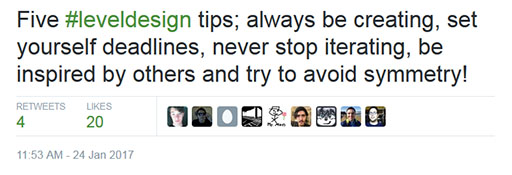
|
|
Always be creating ...
New content! It is easy to stop or pause after finishing
a project and not move on to something else.
If the last project was too stressful or demanding, then try
something with less detail or scope, start experimenting with new
brushwork building methods or different gameplay setups.
Stop the dust from settling and dive right back into your
next masterpiece!
There are many ways to keep momentum going between projects.
Experiment with new themes or texture styles, try to build
some architecture at an odd angle like at 30, 45 or 60 degrees or
find some concept art you like and recreate it to scale!
Set yourself deadlines -
It's easy to get distracted adding details and being absorbed with
tangent ideas when you should be focusing on the end goal,
finishing and releasing your map!
Setting yourself goals will focus your time on what is really
needed and make you think twice about adding stuff that is not
really necessary for the final outcome.
A series of short deadlines are especially good if you are
working with a limited time frame project because you can see progress
much quicker and be more motivated to finish. Deadlines help to
break a map down into smaller steps and more manageable tasks
which can create a much better focused and rewarding map making
experience.
Never stop iterating -
I was once asked to create three different versions of the same encounter
and at the time I could not understand why. It is impossible to know
if your first version is going to be the best iteration if there is
nothing for comparison. What may seem like a waste of time
with duplication of work can be a useful validation of what design
you have finally picked.
Always consider the iteration process if what you are creating is
nothing special or remarkable. Some might say the
downside to the iteration process is that you can create more
work than is required, but that does not mean the process
is worthless. Don't be afraid to iterate because of the
extra work involved, just save the different versions as prefabs.
A real world example of iteration is city architecture,
which often changes as people adapt places to suit their current needs.
Expansions, extensions, extra routes and different styles of
details can all work towards creating a better visual tapestry.
Be inspired by others -
Hardly anyone can be creative in isolation without being
influenced by something else around them. There are countless
images, films and books that swim around our subconscious
allowing us to come up with fresh ideas. If you are suffering
from a creative block or not sure what to do next then search
for concept art, go to the library or buy a coffee in a
bookshop and browse some architecture books.
The Internet has a vast collection of concept images,
architectural photos and
plenty of other types of artwork (sculptures, videos etc.)
that can be used as sources of inspiration.
Even if you take a concept
image literally and create something similar, it will still
be your interpretation and be a useful exercise for building
new content with the editor.
Try to avoid symmetry -
It is so tempting to create symmetry in architecture or
gameplay setups because we see mirrored structures around us
all the time and think it is the right thing to do. You can easily find a
church or modern day building with identical
sides and matching facade features.
Symmetry is something you should be aware of at all times
and actively trying to break.
Try to use 90 degree rotation steps instead of mirroring
functions when copying and pasting architecture (especially floor layouts)
Move various facade elements vertically up or down
to create an imbalance. Look for obvious vertical or
horizontal lines and move elements around to break the pattern.
Change the size of matching (size of flames) objects
and change the style of identical pairs by removing/adding
(boarding up windows with wood) something.
|
|
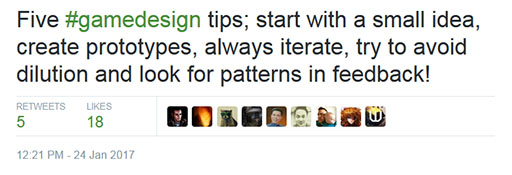
|
|
Start With a Small Idea -
Everyone has grand ideas, projects involving mountains of details
with complex gameplay systems. The problem with these
ideas is that they are extremely difficult to
know exactly where to start. They often involve
so many different steps with such complex planning that they can
easily be abandoned long before they reach a finished prototype stage.
I find creating a small experimental idea using existing
or placeholder assets can be the perfect way to gain momentum on starting
a larger project. A small idea can also give you immediate feedback
and be the perfect moral boast for when working alone or in a small group.
Create Prototypes -
Game design rarely starts with an exact schedules or detailed project plan;
it usually starts with a prototype. A short burst of inspiration to see if
an idea is worth pursuing and developing into a larger
(more organized) project.
Never underestimate the power of prototyping or architectural/art style
experiments. Inspiration is rarely a factory line or an on demand
process and fresh ideas often need space and time to develop. Always set an
end date or goal for a prototype so that it does not drift or lack direction
and bear in mind what you are trying to achieve.
Always Iterate -
Game design ideas are always shaped by iteration and it is highly unlikely
an idea will be perfect first time around. The trick is not to be afraid of change
and let ideas flow in several different directions before settling on the
final choice.
Many game designers rely on feedback from trusted sources or people who can
articulate their issues with constructive feedback. Try to find a diverse
collection of individuals who can help with quick iteration cycles. Not
everyone can separate their emotions from feedback and see the bigger
picture of what the idea is trying to be.
Try to Avoid Dilution -
Be careful about 'watering down' an idea if it has gained a strong negative
feedback reaction. An idea which creates an extreme reaction does not
necessarily mean it is bad; it might be the implementation that is wrong.
Always remember that bold ideas can be the defining moment of a game/map
and should not be shied away from.
The problem with dilution or 'design by committee' is once the core idea is
compromised the overall quality of a game/map can lose its edge. The other
side of the coin is that bold ideas can also be unpopular and
create bipolar feedback. As long as you are happy not to win the popular vote
then don't be afraid to pursue uncompromising ideas.
Look for Patterns in Feedback -
There are many different types of feedback to consider when looking for
advice on game design. The trick to understanding feedback is being able
to filter out the opinions from the constructive advice. It is not easy to
divorce emotion from feedback, but allowing time between reaction and
response is always a good idea.
One way to spot good advice is to look for feedback that forms patterns,
advice which is similar or repeated by several different people. If many
people are experiencing the same response there is a good chance that
the presentation or implementation is wrong for the target audience.
Even though feedback can be passionate and destructive it is by no means
all bad as people will often only be bothered to create feedback when
they care about something.
The classic bipolar response of "I hate" or "I love" can be frustrating but
this is better than no response at all. Some of the
best games are often communicating to us on an emotional level which can
generate such strong responses and this is what great games are all about.
|
|
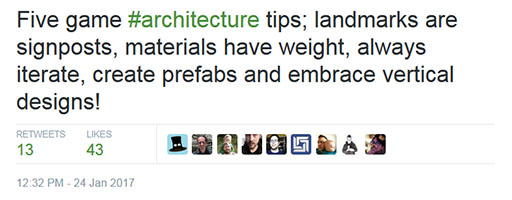
|
|
Landmarks Are Signposts -
If a play tester is getting lost then it may be due to the
map architecture or colour scheme being too similar. Bold
unique details or colours can make a big difference with
helping players build up a mental picture quicker in their head
for navigation.
A landmark does not need to be something ginormous or even
visually impressive, but it does need to be something visually
unique with regards to the rest of the map.
A way to see if this approach is working is trying to
describe every location to a friend using 5 words
or less. For example, the lake of lava, the giant waterfall, the
blue tile room etc. If a location cannot be easily described
with something unique then it is unlikely to be memorable or a good sign.
Once every location in a map has an unique architectural feature
or colour style,
the player is much more likely to be able to move around the
map quickly and spend more time exploring instead of wondering
where they have been already.
Materials Have Weight -
When a game location is built using materials like wood or
stone they will come with preconceptions about their
weight. Building materials often look and feel better when they are
a certain shape relative to their weight. The player is
unconsciously expecting them to be a certain look relative to
their surroundings.
For example a giant undamaged stone pillar should look like it can
support its own weight and stand upright. The thickness, angle
and shape are often derived from the material used and if the pillar
has odd proportions then the presence is diminished.
The same could be said for a stone wall between rooms that is too
thin for the material used and the structural weight looks wrong.
Regardless of how much a game may want to surprise a player
with unbelievable structures and scale, the weight of real
world materials has a great impact on the players impression
of a scene and how believable it looks.
Always Iterate -
This should be a mantra muttered every morning before breakfast!
I cannot stress this enough that most tasks associated with
game design rarely work first time, they are often tweaked,
updated or changed over time.
Architecture will often have more detail added, existing routes
moved around and even silhouettes manipulated once the lighting
is done! Always allow extra time for this by learning to build
architecture over time in layers.
Create Prefabs -
Not everything in a map has to be unique, interactive objects
especially should be visually consistent. A classic use of
prefabs is where an object (button/door) needs to be easily
recognizable by the player for its functions and pop out from
its surroundings as something important.
Some projects like jam or speed creation events do not have
the luxury of endless time and prefabs can be used to fill
in details quickly. If there is enough time left after
gameplay and lighting has been completed then the prefabs
can easily be replaced with better unique detail.
Embrace Vertical Designs -
When walking down the street most people will be looking forward
and rarely will they be looking up at the top of buildings or
down at their feet. People look forward because of their eye position
and do not notice the details in their peripheral vision.
This is why many games take advantage of this by hiding objects
above or below player height.
The trick to vertical designs is to find the right gradient angle,
the right balance by which a player will be willing to look up or down
to notice details and consider it a relevant path to explore.
The first type of vertical design is varied floor heights that
have obvious connections via steps or moveable objects. These
types of designs create better spaces for exploration and
encounters while challenging the player to be spatially aware.
The second type of vertical design are generally isolated or
areas high above the players movement/vision height and not obvious
how they are reachable. These ledges, routes or secret places
should be reusable spaces and offer the player an alternative
viewpoint, a chance to enjoy the previous location but this time
from a height advantage.
A classic mistake that anyone new to level design makes is
create a single floor height room with very little Z axis
interaction. The best way to think about vertical design
is like a Celtic knot, where floors weave up and down,
over and under and create the surprise of an interconnected
location to explore and take advantage of!
|
|
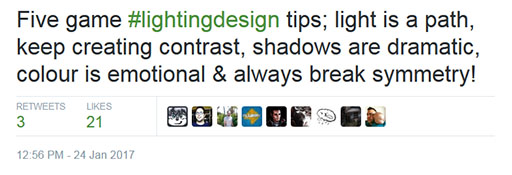
|
|
Light is a path -
Often the primary route through a map is highlighted with arrow signs,
architectural shapes and item/encounter placement. Another possible
type of pathing is the placement of lights, because most
players will automatically be drawn to light and avoid darkness.
To create a path of light place strong light
source next to all architectural exits, highlight the most obvious
route through an area and try using light styles (flashing or blinking)
to focus the player's attention. The lit path
does not need to be the most direct route, much like road signs
in cities are not always the fastest route the same can be said
for paths of light!
Keep creating contrast -
A map with uniform light levels is a badly lit map! Just like
architectural details create better location visuals, the same can
be said for contrasting light. The intensity of light is a way of
drawing attention, moving the player towards a point of interest.
A map full of flat uniform lighting has no sense of direction;
it might as well be a maze!
To create contrasting lights start with darkness and gradually
add light sources with a high intensity value and a long attenuation
to reduce the harsh light boundaries. Once the light sources
have been setup then add ambient fill lights either to smooth the
shadow gradients or if darkness is a prominent game mechanic keep the
ambient fill lights near the light sources instead.
Shadows are dramatic -
When films were black and white cinematographer understood the value
of shadows and realized that architecture was a canvas, a surface to
splash silhouettes upon to suit the mood of the film.
Shadows are more than just
blobs of grey thrown in the corners. Shadows can accent architecture,
create tension and enhance the atmosphere.
When placing light sources always consider nearby architecture and
look for the possibility of a dramatic shadow. A way to distort
a row of bars across a wall, project a silhouette of a cage upon a ceiling
or frame the outline of building across the sky. Dramatic shadows
are impressive, memorable and bring an ordinary flat surface to life.
Colour is emotional -
The colours we see around us in nature
often invoke emotional responses and coloured light is no different.
From a blue cloudless (cold) night sky to a yellow bright (hot) midday sun,
the colour of a scene can help to build an emotional narrative.
Coloured lighting come with player preconceptions and strong reactions
to certain colours that often create an emotional response
like blue/grey for coldness and yellow/red for warmth.
For example a giant two storey wood/stone banquet hall could have
warm fires (yellow) at ground level and be cold (blue) lights close
to the ceilings and around the first floor balconies.
Always break symmetry -
Lights are probably the worst offenders for symmetrical placement because
the lighting is often the final phase to the level design process.
Easily copied and pasted around, many designers will ignore what should be
highlighted and simply duplicate the lights around and sometimes even match
symmetrical architecture at the same time.
The problem with symmetrical light placement is it creates a uniform
light level which is visually dull and to make matters worse
the layout of the shadows are mirrored as well!
A quick and easy solution to this problem is to switch off some of
the light sources and vary some of the light intensities. This will
break the uniformity of light/shadow and create the illusion of
a location which has aged over time because of missing light sources.
|
|
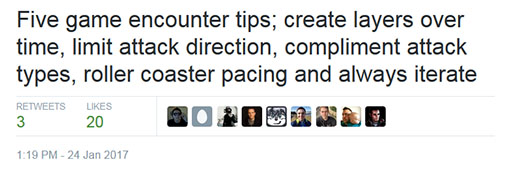
|
|
Create layers over time -
A classic mistake to make when setting up game encounters is to
allow all of the AI to attack at once without any spawn delays.
The player will end up just being overrun by AI from all directions and the
encounter will quickly descends into chaos. There is a good chance that most
players discovering this 'surprise' will not enjoy it.
The trick to any encounters is pacing, to stagger the spawning
over time and create different waves that are triggered via an
event. As the different waves are spawned in, the
encounter can eventually build up to a crescendo event
and a distinct pause. The break in the flow might
seem counter intuitive, but this is the moment to look around,
investigate and explore the environment.
Limit attack direction -
Most players approaching an encounter will expect the enemies to be
attacking them from one direction and will not expect
attacks from multiple angles (side or flank) all at once. This does not mean
multiple attack directions should never be used, but wide
angle (135+ degrees) attacks should either be linked to a skill level
or that the player has plenty of good equipment to cope with
the situation.
Often players will claim they want enemies to be smart and more
intelligent/aggressive with their attacks, but there is a point at
which enemy attacks from too many different angles at once can be regarded
as cheating or a cheap trick by the level designer. If you are
planning to attack the player from multiple angles be aware that
this kind of tactic can become tiresome if used too often.
Compliment attack types -
Most game enemies have a couple (1-2) of different
types (range, melee, AoE or debuff) of attacks and the level
designer is responsible for creating different combinations of
the enemies with complimentary attacks to challenge the
player in different environments.
Each enemy individually should not be much of a threat, but once they
are grouped together they should become part of a complex puzzle of
different threats which the player has to learn how to
prioritize in order to survive.
Some group encounters are more difficult than others and that is mainly
to do with how many of their abilities overlap and how diverse
they are with attack types. A group of enemies which has a
single attack (1 melee or 1 range) will be far easier to deal
with than a group with a large variety of different attacks because of
priority concerns. This is how difficult can be scaled up or down when
creating encounters for the beginning or the end of a map.
Roller coaster pacing -
Many games are built with a pacing, a distinct
ebb and flow to how events unfold and an intensity to the encounters.
Some games vary the rate of pacing by using different activities like
using reflexes for encounters and lateral thinking for puzzles.
When designing a map try to break it down into zones or bubbles of
player activity. Consider each zone being a mixture of different types
of encounters and try to vary the pace by having sections where
there are puzzles.
Remember to keep the combat away from the boundaries to each zone and
don't be afraid to create empty spaces to allow players time
to breath before the next climb upwards on the roller coaster.
Always iterate -
As encounters become more complex with larger groups, multiple waves,
and special events, the testing of the pacing can quickly get time
consuming because the order of each new encounter will affect the
overall flow.
I highly recommend to start the testing at the beginning each time
to make sure the encounters are balanced in sequence, otherwise
there is a good chance a gameplay difficulty spike will appear
due to lack of resources.
|
|
|
|
 |
|
|
|
|













